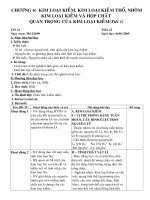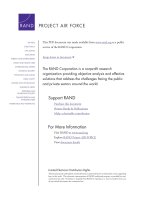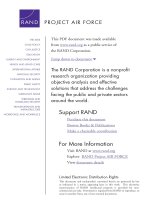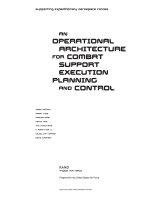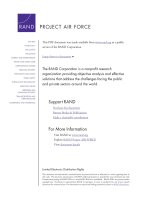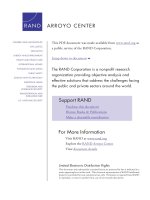Dessler ch 6 rec planning and testing
Bạn đang xem bản rút gọn của tài liệu. Xem và tải ngay bản đầy đủ của tài liệu tại đây (405.47 KB, 52 trang )
Gary Dessler
tenth edition
Chapter 6
Part 2 Recruitment and Placement
Employee Testing and Selection
© 2005 Prentice Hall Inc.
All rights reserved.
PowerPoint Presentation by Charlie Cook
The University of West Alabama
After studying this chapter,
you should be able to:
1.
2.
3.
4.
Explain what is meant by reliability and validity.
5.
List eight tests you could use for employee
selection, and how you would use them.
6.
Explain the key points to remember in conducting
background investigations.
Explain how you would go about validating a test.
Cite and illustrate our testing guidelines.
Give examples of some of the ethical and legal
considerations in testing.
© 2005 Prentice Hall Inc. All rights reserved.
6–2
6–2
Why Careful Selection is Important
The importance of selecting the right
employees
– Organizational performance always depends in
part on subordinates having the right skills and
attributes.
– Recruiting and hiring employees is costly.
– The legal implications of incompetent hiring
• EEO laws and court decisions related to
nondiscriminatory selection procedures
• The liability of negligent hiring of workers with
questionable backgrounds
© 2005 Prentice Hall Inc.
All rights reserved.
6–3
Avoiding Negligent Hiring Claims
Carefully scrutinize information supplied by the applicant on his
or her employment application.
Get the applicant’s written authorization for reference checks,
and carefully check references.
Save all records and information you obtain about the applicant.
Reject applicants who make false statements of material facts
or who have conviction records for offenses directly related and
important to the job in question.
Balance the applicant’s privacy rights with others’ “need to
know,” especially when you discover damaging information.
Take immediate disciplinary action if problems arise.
© 2005 Prentice Hall Inc.
All rights reserved.
6–4
Basic Testing Concepts
Reliability
– The consistency of scores obtained by the same
person when retested with the identical or
equivalent tests.
– Are the test results stable over time?
Test validity
– The accuracy with which a test, interview, and so
on measures what it purports to measure or fulfills
the function it was designed to fill.
– Does the test actually measure what we need for
it to measure?
© 2005 Prentice Hall Inc.
All rights reserved.
6–5
Sample Picture Card from
Thematic Apperception Test
How do you interpret
this picture?
© 2005 Prentice Hall Inc.
All rights reserved.
Source: Harvard University Press. Used with permission.
Figure 6–1
6–6
Types of Validity
Criterion validity
– A type of validity based on showing that scores on
the test (predictors) are related to job
performance (criterion).
• Are test scores in this class related to students’
knowledge of human resource management?
Content validity
– A test that is content valid is one that contains a
fair sample of the tasks and skills actually needed
for the job in question.
• Do the test questions in this course relate to human
resource management topics?
• Is
taking an
HR Inc.
course the same as doing HR?
2005
Prentice
Hall
©
All rights reserved.
6–7
Examples of Web Sites Offering Information
on Tests or Testing Programs
www.hr-guide.com/data/G371.htm
– Provides general information and sources for all types of
employment tests.
/>– Provides technical information on all types of employment and
nonemployment tests.
www.ets.org/testcoll/index.html
– Provides information on over 20,000 tests.
www.kaplan.com/
– Information from Kaplan test preparation on how various
admissions tests work.
www.assessments.biz/default.asp?source=GW-emptest
– One of many firms offering employment tests.
© 2005 Prentice Hall Inc.
All rights reserved.
Figure 6–2
6–8
How to Validate a Test
Step 1: Analyze the job
– Predictors: job specification (KSAOs)
– Criterion: quantitative and qualitative measures of
job success
Step 2: Choose the tests
– Test battery or single test?
Step 3: Administer the test
– Concurrent validation
• Current employees’ scores with current performance
– Predictive validation
• Later-measured performance with prior scores
© 2005 Prentice Hall Inc.
All rights reserved.
6–9
How to Validate a Test (cont’d)
Step 4: Relate Test Scores and Criteria
– Correlation analysis
• Actual scores on the test with actual performance
Step 5: Cross-Validate and Revalidate
– Repeat Step 3 and Step 4 with a different sample
of employees.
© 2005 Prentice Hall Inc.
All rights reserved.
6–
10
Expectancy Chart
Note: This expectancy chart shows the relation between scores made on the Minnesota Paper Form Board and
rated success of junior draftspersons. Example: Those who score between 37 and 44 have a 55% chance of being
rated above average and those scoring between 57 and 64 have a 97% chance.
© 2005 Prentice Hall Inc.
All rights reserved.
6–
11
Figure 6–3
Testing Program Guidelines
1. Use tests as supplements.
2. Validate the tests.
3. Monitor your testing/selection program
4. Keep accurate records.
5. Use a certified psychologist.
6. Manage test conditions.
7. Revalidate periodically.
© 2005 Prentice Hall Inc.
All rights reserved.
6–
12
Table 6–1
Equal Employment Opportunity (EEO)
Aspects of Testing
A organization must be able to prove:
– That its tests are related to success or failure on
the job (validity)
– That its tests don’t unfairly discriminate against
minority or nonminority subgroups (disparate
impact).
EEO guidelines and laws apply to all
selection devices, including interviews,
applications, and references.
© 2005 Prentice Hall Inc.
All rights reserved.
6–
13
Equal Employment Opportunity (EEO)
Aspects of Testing (cont’d)
Testing alternatives if a selection device has
disparate impact:
– Institute a different, valid selection procedure that
does not have an adverse impact.
– Show that the test is valid—in other words, that it
is a valid predictor of performance on the job.
– Monitor the selection test to see if it has disparate
impact.
© 2005 Prentice Hall Inc.
All rights reserved.
6–
14
Sample Test
© 2005 Prentice Hall Inc.
All rights reserved.
Source: Courtesy of NYT Permissions.
6–
15
Figure 6–4
Test Takers’ Individual Rights and Test
Security
Under the American Psychological
Association’s standard for educational and
psychological tests, test takers have the right:
– To privacy and information.
– To the confidentiality of test results.
– To informed consent regarding use of these
results.
– To expect that only people qualified to interpret
the scores will have access to them.
– To expect the test is fair to all.
© 2005 Prentice Hall Inc.
6–
All rights reserved.
16
Using Tests at Work
Major types of tests used by employers
– Basic skills tests (45%)
– Drug tests (47%)
– Psychological tests (33%)
Use of testing
– Less overall testing now but more testing is used
as specific job skills and work demands increase.
• Screen out bad or dishonest employees
• Reduce turnover by personality profiling
Source of tests
– Test publishers
© 2005 Prentice Hall Inc.
All rights reserved.
6–
17
Computer-Interactive Testing
Types of tests
–
–
–
–
Specialized work sample tests
Numerical ability tests
Reading comprehension tests
Clerical comparing and checking tests
Online tests
–
–
–
–
Telephone prescreening
Offline computer tests
Virtual “inbox” tests
Online problem solving tests
© 2005 Prentice Hall Inc.
All rights reserved.
6–
18
Types of Tests
Tests of cognitive abilities
– Intelligence Tests
• Tests of general intellectual abilities that measure a
range of abilities, including memory, vocabulary, verbal
fluency, and numerical ability.
– Aptitude tests
• Tests that measure specific mental abilities, such as
inductive and deductive reasoning, verbal
comprehension, memory, and numerical ability.
© 2005 Prentice Hall Inc.
All rights reserved.
6–
19
Types of Tests (cont’d)
Tests of motor abilities
– Tests that measure motor abilities, such as finger
dexterity, manual dexterity, and reaction time.
Tests of physical abilities
– Tests that measure static strength, dynamic
strength, body coordination, and stamina.
© 2005 Prentice Hall Inc.
All rights reserved.
6–
20
Problem from the Test of
Mechanical Comprehension
Which gear will turn the same way as the driver?
© 2005 Prentice Hall Inc.
All rights reserved.
Source: Reproduced by permission. Copyright 1967, 1969 by The Psychological Corporation, New York, NY. All rights
reserved. Author’s note: 1969 is the latest copyright on this test, which is still the main one used for this purpose.
6–
21
Figure 6–5
Measuring Personality and Interests
Personality tests
– Tests that use projective techniques and trait
inventories to measure basic aspects of an
applicant’s personality, such as introversion,
stability, and motivation.
– Disadvantage
• Personality tests—particularly the projective type—are
the most difficult tests to evaluate and use.
– Advantage
• Tests have been used successfully to predict
dysfunctional job behaviors and identify successful
candidates for overseas assignments.
© 2005 Prentice Hall Inc.
All rights reserved.
6–
22
The “Big Five”
Extraversion
– The tendency to be sociable, assertive, active, and to experience
positive effects, such as energy and zeal.
Emotional stability/neuroticism
– The tendency to exhibit poor emotional adjustment and experience
negative effects, such as anxiety, insecurity, and hostility.
Openness to experience
– The disposition to be imaginative, nonconforming, unconventional,
and autonomous.
Agreeableness
– The tendency to be trusting, compliant, caring, and gentle.
Conscientiousness
– Is comprised of two related facets: achievement and dependability.
© 2005 Prentice Hall Inc.
All rights reserved.
6–
23
Other Tests
Interest inventories
– Personal development and selection devices that
compare the person’s current interests with those
of others now in various occupations so as to
determine the preferred occupation for the
individual.
Achievement tests
– Test that measure what a person has already
learned—“job knowledge” in areas like accounting,
marketing, or personnel.
© 2005 Prentice Hall Inc.
All rights reserved.
6–
24
Other Tests (cont’d)
Web-Based (Online) testing
– Eliminates costly and inefficient paper-and-pencil
testing processes.
– Allows for role-playing by applicants.
– Use of computer-based scoring eliminates rater
bias.
– Provides immediate scoring and feedback of
results to applicants.
– Can be readily customized for specific jobs.
© 2005 Prentice Hall Inc.
All rights reserved.
6–
25



